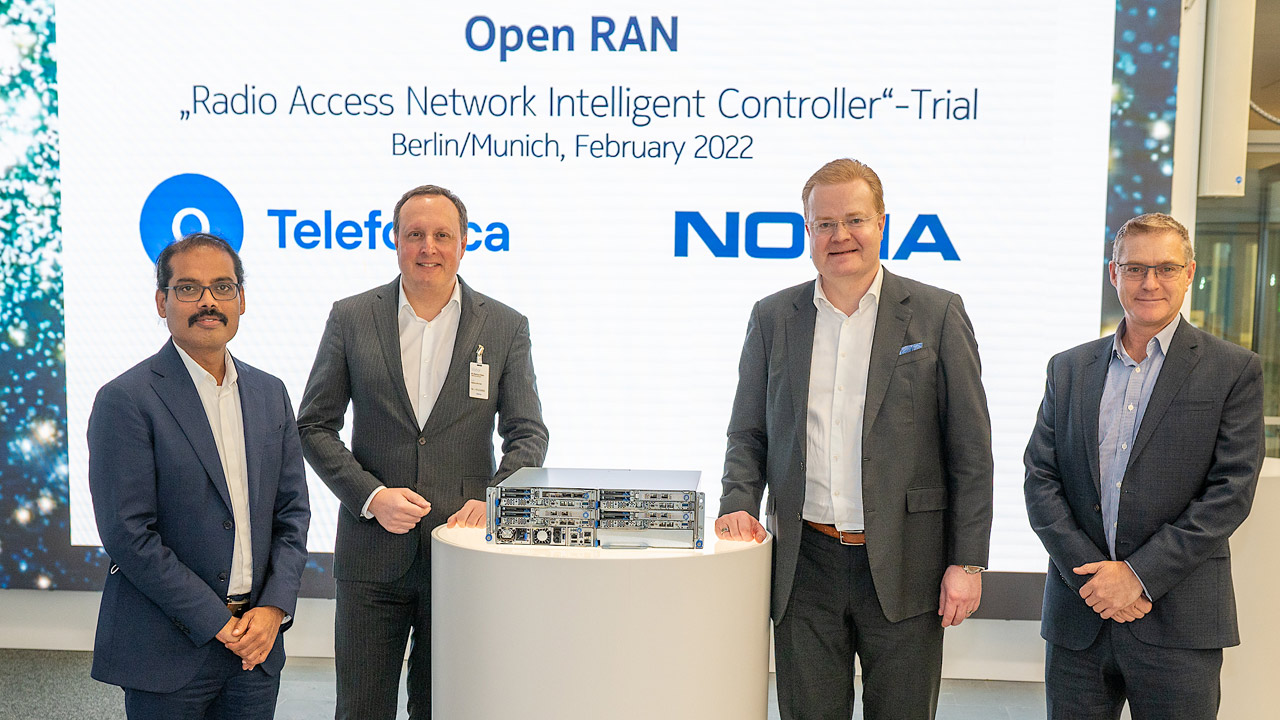17.02.2022
Open RAN in the mobile network: O2 Telefónica uses Nokia artificial intelligence to optimize its mobile network

From the left: Mallik Rao, Markus Haas, Tommi Uitto, Rick Corker
O2 Telefónica is the first German network operator connecting an Open RAN Intelligent Controller (RIC) from Nokia to a mobile communications cluster in its own commercial live network. In the coming months, the artificial intelligence of the RIC will independently optimize the mobile network for customers in the Hellersdorf district of Berlin.
The constant monitoring and optimization of today and future mobile networks is key for provide O2 customers with the best experience as they are thus able to enjoy optimum coverage and performance. This task can now be partially performed by a new technical element in the O2 network: the near-real-time RAN Intelligent Controller (RIC) from Nokia. In a first phase, the RIC will detect unusual behavior of radio cells, based on the rich network data that the RIC gets from those cells. To do this, the new controller continuously analyzes network data of the mobile radio systems concerned - this data does not contain any user information. Thanks to its enormous computing power, it analyzes many parameters and statistics simultaneously and is therefore extremely fast - faster than any human. A total of eleven RAN nodes that currently provide the Berlin population in the Berlin Hellersdorf district with 5G, 4G (LTE) and 2G (GSM) have been connected to the new RAN Intelligent Controller (RIC) in Munich since the beginning of February. The RIC system is currently in the “learning phase”.
“The newly developed RAN Intelligent Controller forms an important element for our network on our way to a perfectly optimized mobile network; with the help of its artificial intelligence, we want to be able to optimize our network faster and more precisely than before. The RIC is an important development step in this regard, as it can control both classic mobile networks and newer, Open RAN-based networks. We are looking forward to the results we gather in the joint trial with Nokia in the coming months and whether they will meet our expectations for AI in the network” says Mallik Rao, Chief Technology & Information Officer at Telefónica Deutschland.
In a second phase, the near-real-time RIC will take decisions to balance the network load of the radio cells, selecting the optimum parameters for the cells from the network data obtained and continuously adjusts them in near real time. By this, a perfect network experience for O2 customers, for example better coverage and higher speeds in the network will be achieved. The RIC was developed on the basis of the O-RAN architecture and will be applied to both classic mobile networks and Open RAN-based networks.
“We are proud to continue the great collaboration with Telefonica in Germany to advance RAN network intelligence utilizing Nokia’s RAN Intelligent Controller. The RIC uses artificial intelligence to optimize the mobile network in near-real-time, detecting and correcting any issues and ultimately enhancing the customer experience with superior coverage and speeds. I look forward to strengthening our partnership and continuing to work closely in this important area,” said Tommi Uitto, President of Mobile Networks at Nokia.
With the RAN Intelligent Controller, the multiple award-winning O2 mobile network also receives a new network function based on an open programming interface (API). This opens up key parts of the RAN network to new applications from the field of artificial intelligence (AI/ML), for example, with so-called xApps than can be programmed by external developers based on standards of the O-RAN Alliance. Such applications could help to further reduce the energy consumption of the systems in the future, for example.
About Open RAN at O2 Telefónica:
O2 Telefónica is a technological pioneer in the use of Open RAN: As the first German provider, O2 Telefónica actively operates ORAN base stations in its live network. Since December 2020, the company has successfully integrated four base stations in Landsberg am Lech into its mobile network. Currently, the company is testing the technology, gaining experience and planning further expansion at other locations once all tests have been successfully completed. In principle, the innovative technological approach of Open RAN offers significantly greater flexibility in the selection of manufacturers in the future. Open RAN is more software-based. This significantly simplifies and accelerates future base station upgrades. Less fixed infrastructure needs to be replaced or exchanged, since updating the software is largely sufficient to bring new services onto the network.
Image material for the network:
Further information about Open RAN at Telefónica: